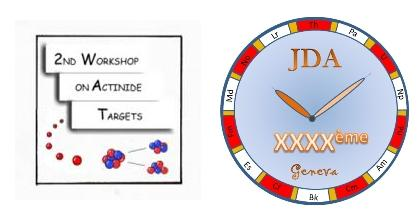Speaker
P Swatek
Description
Transport and thermodynamic properties of UFe2Zn20
Przemysław Swatek and Dariusz Kaczorowski
Institute of Low Temperature and Structure Research, Polish Academy of Sciences,
P.O. Box 1410, 50-950 Wrocław, Poland
e-mail: P.Swatek@int.pan.wroc.pl
Ternary rare-earth-based intermetallic compounds RT2M20 (R = Ce, Gd, Yb; T = d-electron transition metal; M = Zn, Al) crystallize with a cubic structure of the CeCr2Al20-type (space group Fd3m, No. 227) [1-5]. The characteristic feature of the unit cell is that the R atom has only one unique crystallographic site surrounded by as many as sixteen M atoms, which constitute a Frank-Kasper-type nearly spherical polyhedron of cubic symmetry. The shortest R-R spacing is about 6 Å, thus the R atoms may be considered as mutually isolated. In contrast, all the T and M atoms occupy positions (one for T and three for M) with trigonal point symmetry.
Similar compounds with uranium and zinc were reported to form with T = Fe, Co, Ru, Rh, Ir [6-9]. They exhibit a variety of anomalous physical properties governed by different strength of f-d hybridization. The phases UCo2Zn20 and URh2Zn20 were described as paramagnetic heavy-fermion systems with well localized 5f electrons [8,9], while UIr2Zn20 was found to be a heavy-fermion itinerant ferromagnet [7,8]. Very limited information is available for UFe2Zn20. The compound was reported by Goncalves at al. in their pioneering study on polycrystals [6] to be paramagnetic down to 5 K, yet no other than the magnetization and 57Fe Mössbauer data was communicated in the literature up to date.
Single crystals of UFe2Zn20 were grown in Zn flux. The obtained crystals were well-developed cubes with the dimensions up to 60 mm3. Heat capacity and electrical resistivity measurements were performed in the temperature range 0.35 K – 300 K using a Quantum Design PPMS platform. The resistivity was measured with the AC current flowing along the [110] direction.
The temperature variation of the specific heat of UFe2Zn20 is shown in Fig. 1. In agreement with the magnetic data [6], no hint at any phase transition is seen down to 350 mK. The electronic contribution to the specific heat, determined from the region below 7 K (see the inset), is about 180 mJ/(mol K2). This enhanced value of the Sommerfeld coefficient may indicate heavy-fermion character of the compound studied.
Fig. 2 displays the temperature dependence of the electrical resistivity of UFe2Zn20. At room temperature the resistivity is about 160 cm. The resistivity at the terminal temperature of 0.35 K amounts to about 13 μΩcm, yielding the residual resistivity ratio of about 12. These values are similar to those reported for the other UT2Zn20 compounds [7,8]. On decreasing temperature from 300 K down to ca. 130 K, the resistivity increases in a logarithmic manner [ρ(T) = 243.2 - 14.2lnT], hence suggesting significant Kondo contribution to the scattering of conduction electrons. Consequently, the maximum in ρ(T) near 100 K should associated with a crossover from single-ion to coherent Kondo regime. In the latter state, the resistivity decreases rapidly with decreasing temperature, and below 10 K it is proportional to T2 [ρ(T) = 12.8 + 0.143T2], as expected for a Fermi liquid. Combining the specific heat and electrical resistivity data of UFe2Zn20 one obtains the Kadowaki-Woods ratio of 0.43 • 10-5 μΩcm/(mol K2/mJ)2 that is fairly close to the universal value for nonmagnetic Fermi liquid systems (with the orbital degeneracy N = 2).
To summarize hitherto findings, UFe2Zn20 seems to be a novel paramagnetic moderately-enhanced heavy-fermion system, quite similar to the isostructural compounds UCo2Zn20 and URh2Zn20. Further experimental studies aimed at verifying this hypothesis are presently underway and the results will be reported at the conference.
Fig. 1. Temperature dependence of the specific heat of single-crystalline UFe2Zn20. The inset shows the heat capacity data in the form C/T vs. T2. The dashed line emphasizes the linear dependence.
Fig. 2. Temperature variation of the electrical resistivity of single-crystalline UFe2Zn20 (note semilogarithmic scale). The solid and dashed curves mark the Fermi-liquid- and Kondo-like behaviors at low and ambient temperatures, respectively.
References
[1] S. Niemann et al., J. Solid State Chem. 114, 337 (1995).
[2] O. Moze et al., J. Alloys Compd. 268, 39 (1998).
[3] N. Gross et al., J. Solid State Chem. 161, 228 (2001).
[4] S. Jia et al., Phys. Rev. B 77, 104408 (2008).
[5] S. Jia et al., Phys. Rev. B 80, 104403 (2009).
[6] A. P. Goncalves et al., J. Alloys Compd. 271-273, 456 (1998).
[7] E. D. Bauer et al., Phys. Rev. B 74, 155118 (2006).
[8] E. D. Bauer et al., J. Magn. Magn. Mater. 449-451, 310 (2007).
[9] E. D. Bauer et al., Phys. Rev. B 78, 115120 (2008).




